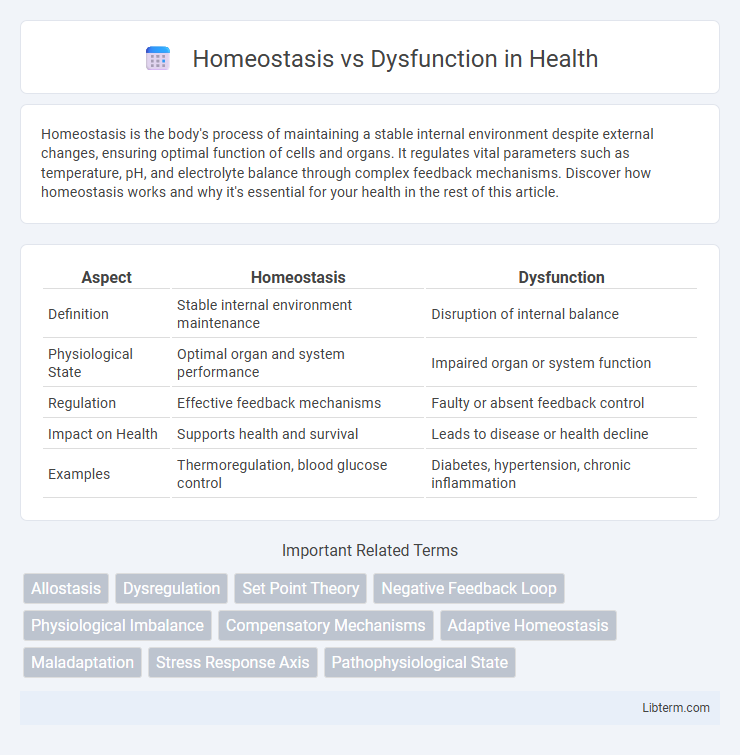Homeostasis is the body's process of maintaining a stable internal environment despite external changes, ensuring optimal function of cells and organs. It regulates vital parameters such as temperature, pH, and electrolyte balance through complex feedback mechanisms. Discover how homeostasis works and why it's essential for your health in the rest of this article.
Table of Comparison
| Aspect | Homeostasis | Dysfunction |
|---|---|---|
| Definition | Stable internal environment maintenance | Disruption of internal balance |
| Physiological State | Optimal organ and system performance | Impaired organ or system function |
| Regulation | Effective feedback mechanisms | Faulty or absent feedback control |
| Impact on Health | Supports health and survival | Leads to disease or health decline |
| Examples | Thermoregulation, blood glucose control | Diabetes, hypertension, chronic inflammation |
Understanding Homeostasis: The Body’s Balance Mechanism
Homeostasis is the body's dynamic process of maintaining internal stability through feedback systems regulating temperature, pH, and electrolyte balance essential for optimal cellular function. Disruption of homeostasis leads to dysfunction, manifesting as disorders like diabetes, hypertension, or acid-base imbalances that impair physiological performance. Key mechanisms involve the hypothalamus and endocrine responses which constantly monitor and adjust internal conditions to sustain equilibrium critical for survival.
Defining Dysfunction: When Systems Go Awry
Dysfunction occurs when biological systems fail to maintain homeostasis, leading to impaired regulation of internal conditions such as temperature, pH, or glucose levels. This disruption triggers pathological states that compromise cellular function and overall health. Understanding dysfunction involves examining how deviations from equilibrium affect physiological processes and contribute to disease development.
Key Processes Involved in Homeostasis
Homeostasis maintains internal stability through key processes such as feedback mechanisms, including negative feedback loops that regulate variables like temperature, pH, and glucose levels. Sensors detect deviations from set points, triggering effectors to restore balance and ensure optimal cellular function. Disruption in these processes leads to dysfunction, resulting in diseases or impaired physiological responses.
Common Factors Leading to Dysfunction
Homeostasis maintains internal stability through balanced physiological processes, while dysfunction arises from disruptions in these systems. Common factors leading to dysfunction include genetic mutations, chronic stress, infections, and environmental toxins that impair cellular and organ function. Nutritional deficiencies and hormonal imbalances also contribute significantly to the breakdown of homeostatic regulation.
Homeostatic Regulation in Major Organ Systems
Homeostatic regulation maintains stability in major organ systems such as the cardiovascular, respiratory, and endocrine systems by continuously monitoring and adjusting physiological variables like blood pressure, oxygen levels, and hormone concentrations. Sensor mechanisms detect deviations from set points, triggering effectors that restore equilibrium through feedback loops, primarily negative feedback. Dysfunction disrupts this balance, leading to conditions like hypertension, respiratory failure, or hormonal imbalances, emphasizing the critical role of homeostasis in health maintenance.
Symptoms and Signs of Homeostatic Imbalance
Homeostatic imbalance manifests through symptoms such as fatigue, weakness, headache, and dizziness, signaling the body's inability to maintain internal stability. Signs of dysfunction include abnormal body temperature, irregular heart rate, elevated blood pressure, and altered respiratory rate, indicating physiological disruption. These clinical indicators reflect the failure of regulatory mechanisms to restore equilibrium, often leading to disease progression.
Environmental and Genetic Triggers of Dysfunction
Environmental triggers such as toxins, pollutants, and chronic stress disrupt cellular homeostasis by causing oxidative damage and inflammation, leading to tissue dysfunction. Genetic mutations affecting key regulatory genes, such as those involved in metabolism, immune response, and repair mechanisms, predispose individuals to impaired homeostatic balance and increased susceptibility to diseases. Both environmental insults and inherited genetic variants interplay to compromise physiological equilibrium, driving the progression from homeostasis to dysfunction in organ systems.
Consequences of Prolonged Dysfunction
Prolonged dysfunction in homeostasis disrupts the body's internal balance, leading to chronic diseases such as diabetes, hypertension, and autoimmune disorders. Cellular damage, inflammation, and impaired organ function result from sustained homeostatic imbalance, escalating health risks over time. Failure to restore equilibrium can cause irreversible tissue damage and systemic complications, significantly reducing lifespan and quality of life.
Strategies to Restore and Maintain Homeostasis
Restoring and maintaining homeostasis involves targeted strategies such as regulating body temperature through sweating or shivering, balancing blood glucose levels via insulin and glucagon release, and maintaining fluid and electrolyte balance through kidney function. Adaptive physiological responses include cellular repair mechanisms, hormone regulation, and feedback loops that counteract dysfunction caused by disease or environmental stressors. Effective homeostatic control depends on the integration of the nervous and endocrine systems to detect imbalances and initiate corrective actions promptly.
Homeostasis vs Dysfunction: Impacts on Overall Health
Homeostasis maintains the body's internal stability by regulating factors such as temperature, pH, and glucose levels, essential for optimal cellular function. Dysfunction disrupts these regulatory processes, leading to imbalances that can cause chronic diseases like diabetes, hypertension, and autoimmune disorders. Sustaining homeostasis promotes overall health by supporting immune response, metabolic efficiency, and tissue repair, whereas dysfunction accelerates disease progression and impairs physiological resilience.
Homeostasis Infographic

 libterm.com
libterm.com